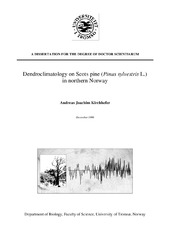| dc.contributor.advisor | Kovacs, Kit M. | |
| dc.contributor.advisor | Lydersen, Christian | |
| dc.contributor.advisor | Ims, Rolf A. | |
| dc.contributor.advisor | Ahonen, Heidi | |
| dc.contributor.author | Martínez Llobet, Samuel | |
| dc.date.accessioned | 2020-08-17T13:30:24Z | |
| dc.date.available | 2020-08-17T13:30:24Z | |
| dc.date.issued | 2019-08-15 | |
| dc.description.abstract | Male bearded seals use vocal displays to attract females and compete with other males during the
mating period, making it possible to monitor breeding populations using passive acoustic
monitoring (PAM). This study analysed year-round acoustic data from underwater recorders at
three sites with different environmental conditions in Svalbard (Norway). Male bearded seals
vocalised for an extended period at the drift-ice site (Atwain; January-July), while the vocal
season was shorter at the fast-ice site (Rijpfjorden; February-June) and shortest at a site where a
dramatic reduction in sea ice cover has occurred (Kongsfjorden; April-June). Generalised
Additive Models showed marked seasonal segregation in the use of different trill call types at
Atwain where call rates reached 400 per h, with long trills dominating during the study period
over step and sweep trills. Modest seasonal segregation was seen at Rijpfjorden, where call rates
reached 300 per h and no seasonal segregation in trill types occurred in Kongsfjorden (peak call
rate 80 per h). Sea ice cover was available throughout the vocal season at Atwain and
Rijpfjorden, while at Kongsfjorden there was a mismatch between the peak in vocal activity
(May-June) and the time when ice was present (until April). Some call types might be
preferentially used if their properties make them more suitable for attracting females in certain
environments. This study provided novel information about vocalising male bearded seals at
sites with different environmental conditions in Svalbard and confirmed that PAM is a useful
tool for studying this species in a warming Arctic. | en_US |
| dc.identifier.uri | https://hdl.handle.net/10037/19000 | |
| dc.language.iso | eng | en_US |
| dc.publisher | UiT Norges arktiske universitet | en_US |
| dc.publisher | UiT The Arctic University of Norway | en_US |
| dc.rights.accessRights | openAccess | en_US |
| dc.rights.holder | Copyright 2019 The Author(s) | |
| dc.rights.uri | https://creativecommons.org/licenses/by-nc-sa/4.0 | en_US |
| dc.rights | Attribution-NonCommercial-ShareAlike 4.0 International (CC BY-NC-SA 4.0) | en_US |
| dc.subject.courseID | BIO-3950 | |
| dc.subject | VDP::Mathematics and natural science: 400::Zoology and botany: 480::Ecology: 488 | en_US |
| dc.subject | Arctic | en_US |
| dc.subject | VDP::Mathematics and natural science: 400::Zoology and botany: 480::Ecology: 488 | en_US |
| dc.subject | Erignathus barbatus | en_US |
| dc.subject | VDP::Mathematics and natural science: 400::Zoology and botany: 480::Ecology: 488 | en_US |
| dc.subject | Mating period | en_US |
| dc.subject | VDP::Mathematics and natural science: 400::Zoology and botany: 480::Ecology: 488 | en_US |
| dc.subject | Passive acoustic monitoring | en_US |
| dc.subject | VDP::Mathematics and natural science: 400::Zoology and botany: 480::Ecology: 488 | en_US |
| dc.subject | Trill | en_US |
| dc.subject | VDP::Mathematics and natural science: 400::Zoology and botany: 480::Ecology: 488 | en_US |
| dc.subject | Sea ice | en_US |
| dc.title | Bearded seal vocalisations across seasons and habitat types in Svalbard (Norway) | en_US |
| dc.type | Master thesis | en_US |
| dc.type | Mastergradsoppgave | en_US |


 English
English norsk
norsk



